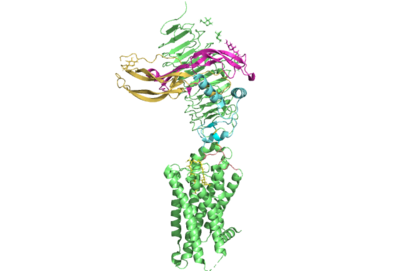This is a default text for your page '. Click above on edit this page' to modify. Be careful with the < and > signs.
You may include any references to papers as in: the use of JSmol in Proteopedia [1] or to the article describing Jmol [2] to the rescue.
Introduction

Figure 1. TSHR with TSH bound
Thyroid hormones exercise essential functions related to thymocyte activity as well as metabolic processes and oxygen consumption. Misregulation of thyroid hormones is the cause of many disorders related to hypo- or hyperthyroidism. Thus, understanding the signaling of synthesis and release of these hormones is essential to the development therapeutic drugs to combat specific thyroid hormone disorders[3]. The initiation of the synthesis and release of these hormones is caused by the glycoprotein, thyroid stimulating hormone, commonly referred to as TSH or thyrotropin. The thyrotropin receptor (TSHR) is a G-protein coupled receptor that binds TSH and transduces signal to initiate synthesis and release of thyroid hormones. It is important to note that autoantibodies may also bind to this receptor causing inhibition or activation of its desired function. (Figure 1)[4][5].
Structure
Overview
The thyrotropin receptor has an extracellular domain (ECD) that is composed of a leucine rich repeat domain (LRRD) as well as the hinge region. This hinge region links the ECD to the seven transmembrane helices, which span from the extracellular domain to the intracellular domain [6]. When thyrotropin or an autoantibody binds, it causes a conformational change in the receptor through the transmembrane helices. This causes the thyrotropin receptor to interact differently with its respective G-protein when in the active and inactive states.
7 Transmembrane Helices
The thyrotropin receptor is anchored to the membrane through seven transmembrane helices which is characteristic of
Hinge Region
Several parts of TSHR are very important for the functioning of TSH signaling. The has been found to have impact on thyrotropin and autoantibody binding. However, the region is not required for the activation of the sensor. This is supported by the fact that select autoantibodies are able to bind to the activate the receptor without any contacts, change to the hinge region. This may be explained by the fact that
Relevance
Structural highlights
This is a sample scene created with SAT to by Group, and another to make of the protein. You can make your own scenes on SAT starting from scratch or loading and editing one of these sample scenes.

